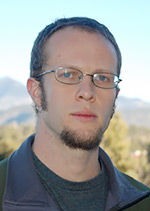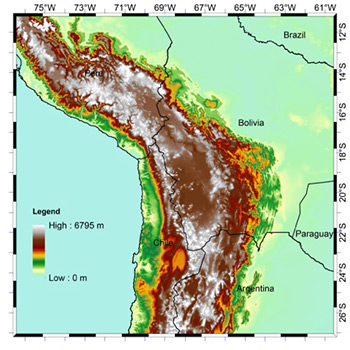Saylor Awarded $380,000 NSF Grant to Study Evolution of Topography in the Peruvian
Andes
Award Supports Paleoelevation and Basin Evolution Research
Joel Saylor, assistant professor in the Department of Earth and Atmospheric Sciences, received a three-year National Science Foundation (NSF) award for $380,000 to study the evolution of high topography in the Peruvian Central Andean Plateau.
 The three-year project, entitled “Cenozoic basin development and environmental change
in the Peruvian Altiplano and implications for uplift mechanisms,” will support ongoing
research by Saylor, Ph.D. student Kurt Sundell, and future EAS graduate and undergraduate
students. The award will strengthen international scientific collaborations by involving
colleagues and students at the Universidad Nacional de San Antonio Abad del Cusco
(UNSAAC) in Peru and supporting scientific exchanges between UH and UNSAAC.
The three-year project, entitled “Cenozoic basin development and environmental change
in the Peruvian Altiplano and implications for uplift mechanisms,” will support ongoing
research by Saylor, Ph.D. student Kurt Sundell, and future EAS graduate and undergraduate
students. The award will strengthen international scientific collaborations by involving
colleagues and students at the Universidad Nacional de San Antonio Abad del Cusco
(UNSAAC) in Peru and supporting scientific exchanges between UH and UNSAAC.
Surface elevation is a first-order reflection of the geodynamic mechanisms that create and sustain large mountain belts and plateaux. Surface elevation also impacts the global climate system and provides barriers to migration that promote speciation. Finally, because foreland basins host important hydrocarbon reserves, determining the timing and magnitude of the topography that causes subsidence in adjacent foreland basins has important implications for hydrocarbon exploration.
 The Central Andean Plateau (CAP) is the largest plateau on Earth formed in a subduction
setting, and its history of elevation gain has been the focus of research for over
a decade. Possible scenarios include a long, slow history of elevation gain over >30
million years. Alternatively, recent research shows that the plateau may have risen
rapidly over the course of several million years and that the modern high elevations
may be quite young.
The Central Andean Plateau (CAP) is the largest plateau on Earth formed in a subduction
setting, and its history of elevation gain has been the focus of research for over
a decade. Possible scenarios include a long, slow history of elevation gain over >30
million years. Alternatively, recent research shows that the plateau may have risen
rapidly over the course of several million years and that the modern high elevations
may be quite young.
Research on these topics has focused on the Bolivian and Argentinian CAP. This project will integrate stable isotope archives of paleoelevation with the records of basin formation and filling to extend the history of elevation gain into southern Peru. The project will use the deuterium/hydrogen ratio in volcanic glass deposits of various ages to reconstruct elevation through time. The composition of ancient water is incorporated into volcanic glass when it erupts. Knowing the isotopic composition of the glass, researchers can use the strong inverse relationship between deuterium/hydrogen ratio in precipitation and elevation to calculate elevation. The project will also look at the development of basins in the Central Andean Plateau to establish where and when subsidence was occurring and the origin of the sediments filling the basins.